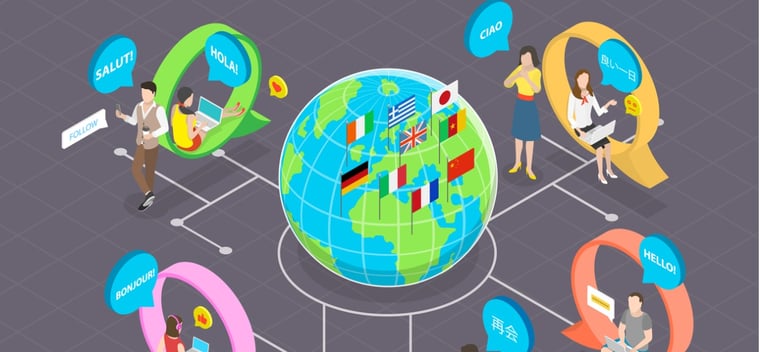
Social media is often the quickest and most direct way to speak to your customers, or potential customers. It can quickly convey your brand’s style and create immediate awareness without feeling like a hard sell. Getting it right is important. Getting it right as you head into new markets could be critical to whether you succeed or fail in that market.
At LinguaLinx, as a Language Services Provider (LSP), we talk with a lot of clients who treat social media as an afterthought. It’s not their fault, they have more structured creative campaigns that have a more formal localization process.
So, this is where a good LSP comes in. To look at the goals of the business as a whole and make sure all messaging, through all channels, is consistent, relevant and targets the channel properly.
Let’s take a look at the top things to consider when translating content for social.
Get The Channels Right
In North America a brand might post frequently on Instagram, FaceBook, X (previously Twitter), TikTok and LinkedIn. That’s a pretty good stable of platforms to gain market share almost anywhere in the continent.
However, if you want to talk to the over 1.4 billion people in China, none of these platforms will work. They’re all banned. As CNN reports, even though TikTok was “developed with homegrown Chinese technology” it isn’t available in China.
And there’s no point translating content that won’t be used. If you’re heading into China, your social media strategy should be targeting users of Sina Weibo (573 million monthly users),
WeChat, Douyin (TikTok’s cousin), Baidu Tieba or Tencent QQ. But just pop across the Formosa Strait to neighboring Taiwan and you’ll want to get back on Facebook, Instagram and X (Twitter).
Translate Social For Social
It may sound obvious, but your messaging for social media channels needs to be translated with various social media channels in mind. A blanket translation of your social copy might not work across all your platforms.
Is the tone of voice you’re using for Instagram the same as you’d use for LinkedIn? In Italy, are you going to open with “buongiorno” or “ciao”? Same meaning, but they speak to your audience on your behalf in very different ways.
Each individual social platform needs to be considered in its own right in order to achieve maximum effectiveness. It’s often only a small tweak in the translation that can make all the difference.
#researchyourhashtags
Hashtag relevance can give you wider reach and selecting hashtags is a science in its own right. Do you need to adapt any of your hashtags for a new region? Do your hashtags form part of a sentence, or are they all at the end of your post? Are they terminology or jargon that only works in English.
Give it some thought, as getting your hashtags wrong will not only be ineffective at drawing in a wider audience, but also scream out that you don’t really care about the territory.
It’s Not Just The Words
Images and video are arguably more important than text today when it comes to social media. The meteoric rise of TikTok proves that people want to scroll and what stops them scrolling on past your content is rarely words.
So, imagine your clothing brand is heading into Saudi Arabia and your images are of women with parts of their bodies exposed in a way that’s perfectly acceptable in Western countries, but disrespectful in this heavily muslim country. You’re not only going to alienate your audience, but you might not be legally allowed to show your content in this lucrative territory.
Always consider visual imagery and make sure part of your translation process involves making sure it is localized appropriately.
Emojis Need Translating Too
Emojis are very easily forgotten in the translation process. After all, everyone in the world knows what a smile is. It’s an international display of warmth, happiness and greeting. That’s as maybe, but what about a thumbs-up? It means everything’s going right, things are okay and we’re happy with how things are proceeding. International too, right?
No. In Iran, Afghanistan and parts of Greece and Italy a thumbs-up means “up yours”. More than just a slight difference of message.
Just like images, do your research on the emojis and whatever you do, never use the middle finger emoji in the UAE or you could be fined over $135,000 and deported…after serving a prison sentence.
How To Get It Right
Social media moves fast. That’s the point. It’s social. If you’re relying on it as part of your communications or localization strategy, you need to be seamlessly talking to your audience like you’re one of them. The best way to do this is to partner with a good LSP and they’ll guide you through the process, while keeping the bigger picture in mind. After all, it’s rare that your requirements will begin and end with social media.
Your LSP will help you select the right platforms, tailor content specifically for those platforms, and make sure your text, imagery and emojis say the right message to the right audience.
Get A Quote For Your Social Media Translation Needs
If you’re looking for a quote for social media translation, or any form of localization, we’d love to sit down and talk with you about it.
Consultations are free and there’s no obligation.
With LinguaLinx, you won't ever have to worry about your message getting lost as it’s translated. You know you're in good hands as we’re ISO 17100 and ISO 9001 compliant, have over twenty years of professional translation experience, and have earned the trust of organizations around the world.






